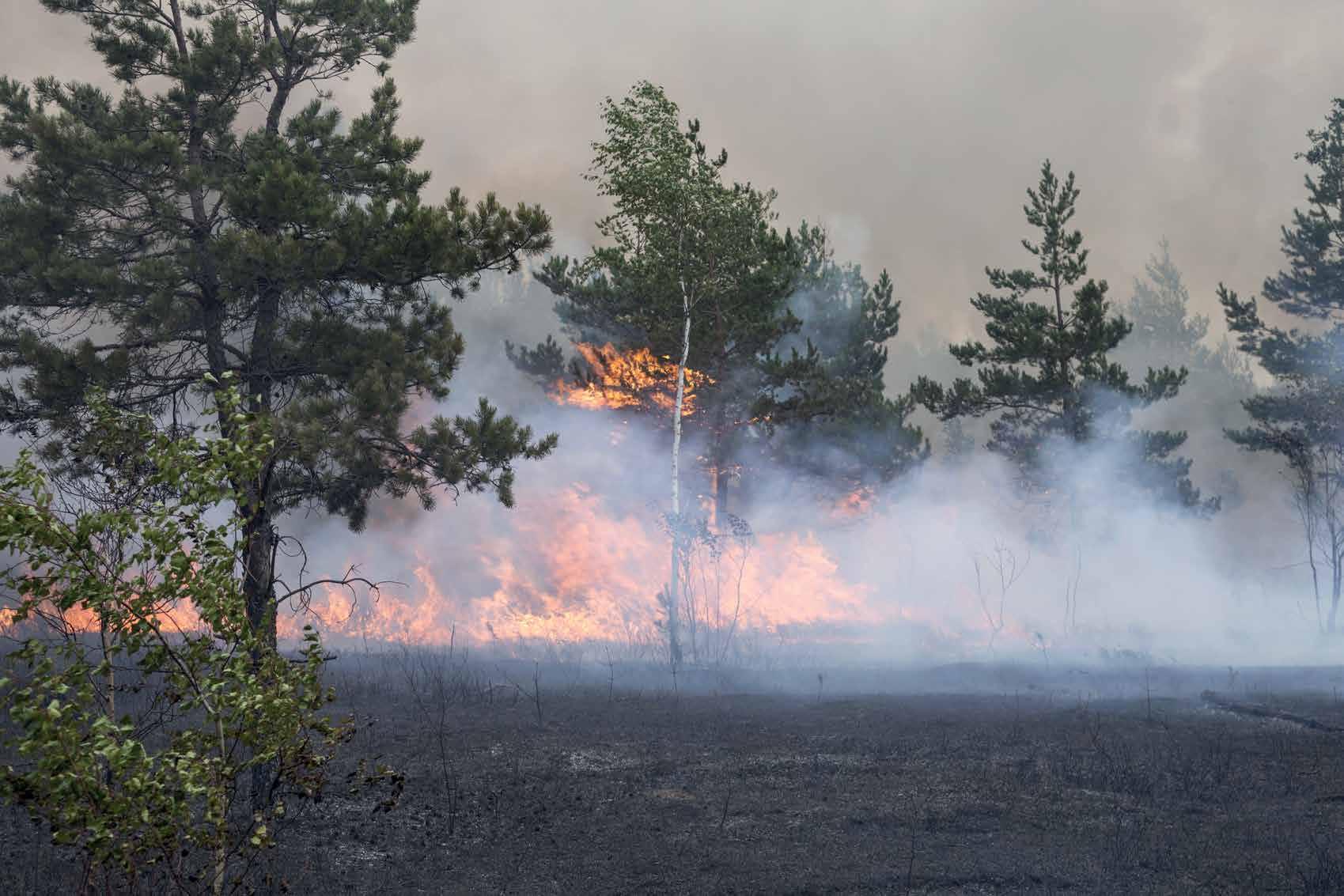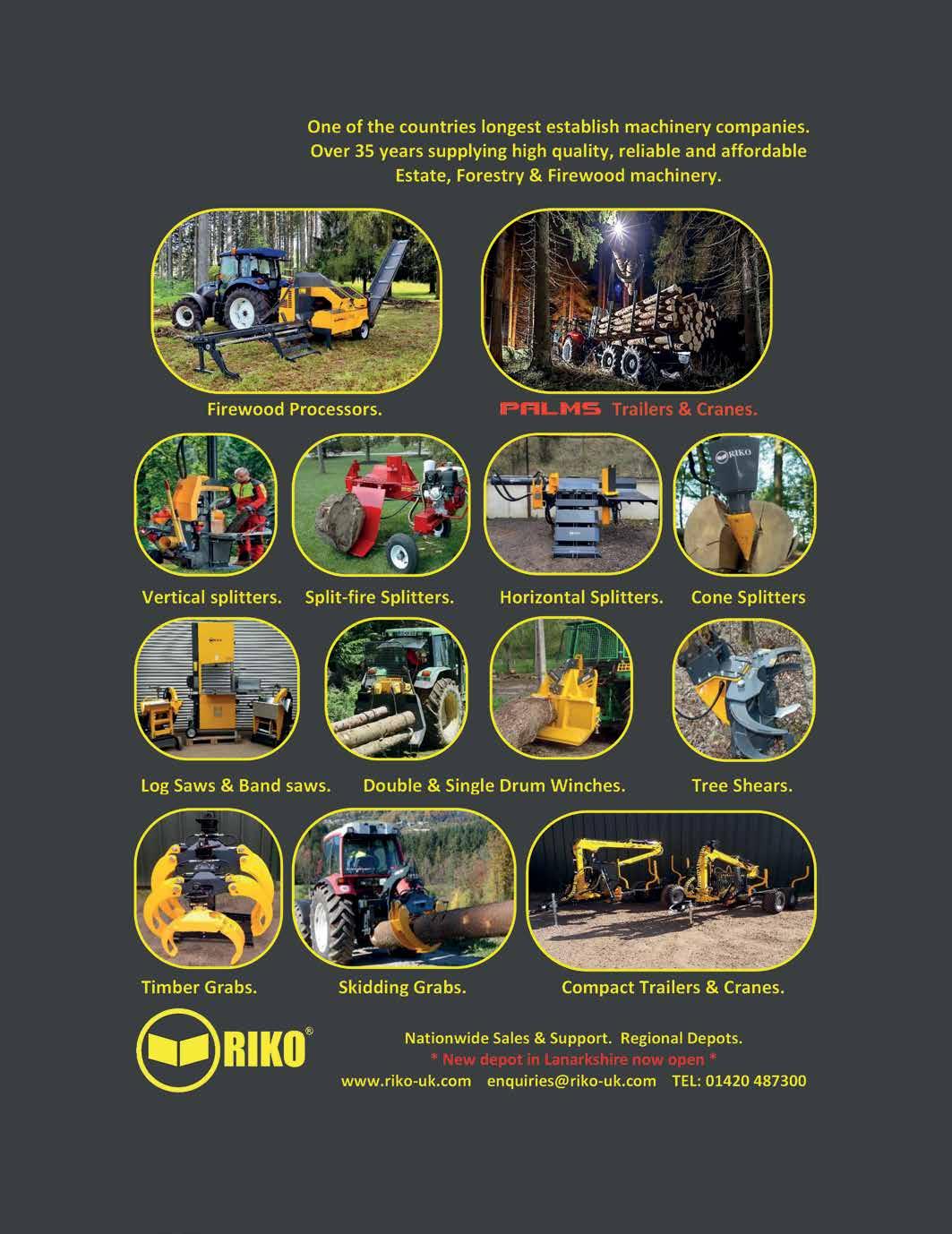
8 minute read
MACHINERY
Fire danger
RAB Easton on the threat of forest fires – and how we deal with them
Forest fires are large, uncontrolled fires which are extremely difficult for fire fighters to contain due to the amount of dry, inflammable fuel found in the forest. They can have devastating effects on forests, woodland wildlife, forest dwellings and even human lives.
When I was working for the Forestry Commission in the 1970s, one year we attended three forest fires in succession.
The largest of the three was in Gwydyr Forest, close to Betws Y Coed in North Wales, and this fire was completely out of control. Forestry squads were drafted in from all over Wales to fight it and they were backed up by both the Fire Brigade and the Royal Engineers with Green Godess Fire Tenders. Hundreds of people were involved and it took almost two weeks to get it under control. With forest fires, the fight takes place on two fronts: the ground fire, which feeds on the combustible deadwood, mosses, grasses and peat found on the forest floor, and then the tree crown fire, which spreads from tree to tree depending on the direction of the wind. This is what makes tackling forest fires extremely difficult and dangerous as the two fires can spread in different directions.
As a young, fit chainsaw operator, my duties were to fell trees in front of the fire to try and create a fire break; the idea was to create a gap wide enough to contain the spread of the crown fire. Sometimes the fire would travel faster than we anticipated and we would be engulfed in smoke, which was absolutely terrifying. I would find myself literally running for my life, unable to breathe or see properly while wearing full PPE and carrying felling accessories, a fuel combi can and my chainsaw. Hitting clean air was such a relief that I could almost cry – my heart felt like it was trying to burst out of my chest and every breath felt like it was scorching my lungs.
Luckily, I have never attended fires as significant as this since then and there have not been as many big forest fires in the UK in recent years. However, this could all change in the future.
There are factors we are unable to change which could contribute to an increase in forest fires in the coming years.
Climate change will have a massive effect on our forests and there is nothing we can do to reverse this as the Earth’s climate system responds
extremeextreme

slowly to past emissions. Regardless of our future emissions, we are locked in for the next few decades. With climate change comes global warming and this will increase summer droughts, which could lead to a large increase in fi res. For example, droughts can make some tree species more susceptible to infestations from insects such as beetles; the warmer climate increases their reproduction cycle, ultimately killing more trees and leaving forests much more combustible. The warmer, dry conditions will also increase the hazard of lightning storms, which have been a natural cause of ignition for many forest fi res in the past.
People’s lifestyles have changed recently and this has led to an increase in the number of people using the forests for recreation and leisure. This might exacerbate the

problem with accidental and sometimes malicious fi res.
Warm dry weather in early spring, just before the growing season begins, is the most hazardous scenario for forest fi res, and this is when everyone has to be most vigilant.
If you see smoke coming from a forest or land nearby at any time of the year please don’t assume that someone else has reported it; call the emergency services immediately. It is much easier to contain a small fi re that has just ignited rather than a full-on forest fi re.
Fighting forest fi res is a nightmare for the emergency services as lack of water can be an issue and the rough terrain means that many fi res have to be fought manually. problem with accidental and sometimes malicious fi res.
Warm dry weather in early spring, just before the growing season begins, is the most hazardous scenario for forest fi res, and this is when everyone has to be year please don’t assume that someone else has reported it; call the emergency services immediately. It is much easier to contain a small fi re that has just ignited rather Fighting forest fi res is a night
The Rosenbauer Polaris Ranger 900EPS EFI 4x4 and 800EPS EFII 6x6 (above) are both fi tted with the Poly ATV SL100 >>


Bijol MTF 240 Fire Combi Truck Some manufacturers have been exploring ways to convert off-road vehicles and forestry equipment so that fi res can be contained much more quickly.
This October, while visiting Austrofoma (Austria’s main forestry exhibition which is held every four years), I spotted the Bijol MTF 240 Fire Combi Truck.
Bijol have used their large forwarder, the BWS 240, and converted it into an off-road fi re fi ghting machine. Band tracks and/or wheel chains can be used to provide added traction and lower the ground pressure when needed. All the components used in this build are to the highest standards available as reliability is a major factor for this type of machine. It has a Deutz sixcylinder 240hp motor and a powerful load sensing hydraulic system with a working pressure of 250 bar. Mounted on the front is a 2.3m wide mulcher capable of dealing with good sized trees for creating fi re breaks, while the rear holds two 11.5 tonne Uniforest winches. It can be fi tted with either a 5000 or 10,000L water tank and has plenty of storage for other fi re fi ghting equipment, gas masks and hoses.
Another feature is a Palfi nger Epsilon 11m reach crane with a tilting king post for steep conditions, which >>

includes has a fi re fi ghting hose with a 60m water jet attached for precision fi re fi ghting. Fire fi ghters can use an additional three water hoses simultaneously. A lot of thought has gone into the fi ne details; for example, the tyres are fi re retardant, there is a smoke fi lter in the cabin to protect the operator, and it has a selfextinguishing system fi tted around the entire machine. It has a higher road speed than some other similar sized machines and will achieve 30km/hr. Another clever feature is that it can be remotely driven from outside the cabin. My only concern with this machine was that, for the large part of the year when the risk of fi res is non-existent, it would be a lot of money standing idle. I spoke to the people at Bijol and voiced my concerns and they were quick to point out that it is not diffi cult to remove the fi re fi ghting equipment, facilitating use as a forwarder or clam bunk skidder.
This model was a prototype and Bijol are happy to work with customers to build these machines to their individual requirements. The Bijol, although an excellent machine, may not be practical and is probably far too expensive for some smaller forestry estates.
Other manufacturers have seen this as well and designed much smaller, affordable units which can be trailer or quad mounted. Bijol MTF240 Fire Combi Truck in action
Rosenbauer One such company is Rosenbauer, the world’s leading manufacturer of fi re fi ghting equipment and protection. They are an Austrian company with over 150 years history in fi re fi ghting technology and they have a UK base in Yorkshire. Their products include two Poly ATV SL100 based conversions, a four-wheel drive and a six-wheel drive. This type of vehicle is invaluable as many replanted forests have had quad tracks created for re-stocking and fencing. Their low ground pressure, compactness and rapid speed makes them ideal for travelling along grass rides and through standing plantations to help contain the fi re.
The Poly systems are independent and, with their own 6ltr compressed air bottle, do not require any external energy or technology. The system is fi tted with a 100ltr water tank with a fl ow rate of 22ltr/min, allowing it to spray at a distance of 16m or a height of 10m. It can spray either water or a foam compound through its 19mm diameter x 40m long hose reel. A fi xed or adjustable nozzle is available.
The company uses two models of the Polaris Rangers. The fi rst is the 4WD 900XP EPS EFI, which has a 900cc two-cylinder petrol engine, PVT automatic transmission with high and low speed, and switchable all-wheel drive. It can carry three people including the driver and will reach speeds of 68km/hr.
The 6WD version has an 800cc two-cylinder engine with the same type of transmission and seats but has a lower top speed of 40km/hr.
Perhaps the fi res that I attended would not have escalated so dramatically if these vehicles had been available.
Rab Easton is the editor of the bi-monthly Forest Machine Magazine. He is a second generation logger with over 40 years of hands on experience in timber harvesting. Rab’s magazine is available both in print and online and he is very active on Twitter and Facebook. www.forestmachinemagazine.com a @forestmachineoj b @forestmachineoperatorjobs Rab Easton is the editor of the www.forestmachinemagazine.com










